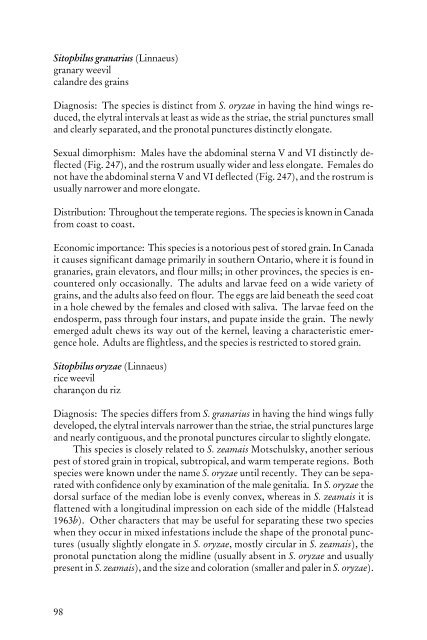Beetles Identification Guide
Beetles Identification Guide
Beetles Identification Guide
You also want an ePaper? Increase the reach of your titles
YUMPU automatically turns print PDFs into web optimized ePapers that Google loves.
Sitophilus granarius (Linnaeus)<br />
granary weevil<br />
calandre des grains<br />
Diagnosis: The species is distinct from S. oryzae in having the hind wings reduced,<br />
the elytral intervals at least as wide as the striae, the strial punctures small<br />
and clearly separated, and the pronotal punctures distinctly elongate.<br />
Sexual dimorphism: Males have the abdominal sterna V and VI distinctly deflected<br />
(Fig. 247), and the rostrum usually wider and less elongate. Females do<br />
not have the abdominal sterna V and VI deflected (Fig. 247), and the rostrum is<br />
usually narrower and more elongate.<br />
Distribution: Throughout the temperate regions. The species is known in Canada<br />
from coast to coast.<br />
Economic importance: This species is a notorious pest of stored grain. In Canada<br />
it causes significant damage primarily in southern Ontario, where it is found in<br />
granaries, grain elevators, and flour mills; in other provinces, the species is encountered<br />
only occasionally. The adults and larvae feed on a wide variety of<br />
grains, and the adults also feed on flour. The eggs are laid beneath the seed coat<br />
in a hole chewed by the females and closed with saliva. The larvae feed on the<br />
endosperm, pass through four instars, and pupate inside the grain. The newly<br />
emerged adult chews its way out of the kernel, leaving a characteristic emergence<br />
hole. Adults are flightless, and the species is restricted to stored grain.<br />
Sitophilus oryzae (Linnaeus)<br />
rice weevil<br />
charançon du riz<br />
Diagnosis: The species differs from S. granarius in having the hind wings fully<br />
developed, the elytral intervals narrower than the striae, the strial punctures large<br />
and nearly contiguous, and the pronotal punctures circular to slightly elongate.<br />
This species is closely related to S. zeamais Motschulsky, another serious<br />
pest of stored grain in tropical, subtropical, and warm temperate regions. Both<br />
species were known under the name S. oryzae until recently. They can be separated<br />
with confidence only by examination of the male genitalia. In S. oryzae the<br />
dorsal surface of the median lobe is evenly convex, whereas in S. zeamais it is<br />
flattened with a longitudinal impression on each side of the middle (Halstead<br />
1963b). Other characters that may be useful for separating these two species<br />
when they occur in mixed infestations include the shape of the pronotal punctures<br />
(usually slightly elongate in S. oryzae, mostly circular in S. zeamais), the<br />
pronotal punctation along the midline (usually absent in S. oryzae and usually<br />
present in S. zeamais), and the size and coloration (smaller and paler in S. oryzae).<br />
98
















